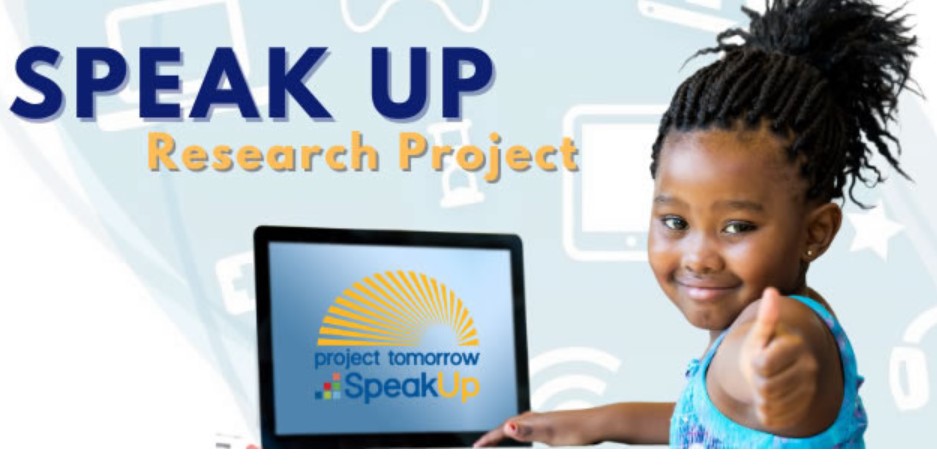How the Sudden Shift in Digital Learning Has Created New and Sustainable Changes in K-12 Education
Educators and parents now more strongly embracing digital learning, according to the 2020 Speak Up Report from Project Tomorrow

The sudden shift in digital learning in spring 2020 has resulted in increased usage of digital tools by teachers and students, according to the recent Speak Up National Report from Project Tomorrow, a national education nonprofit organization.
The report also finds stronger appreciation by parents for the value of technology as a learning vehicle and their role in supporting their child’s education from home. The number of parents who said technology is ‘Very important’ rose from 55% to 75% this spring, says Dr. Julie A. Evans, researcher and CEO of Project Tomorrow.
“Parents would say, ‘Yes yes yes, I understand how technology is being used in my child’s learning life,’ but what they were thinking about is going to a school portal to see their child got a B on a paper,” says Evans. “But by having their students learning right next to them at the kitchen table, using a Chromebook from school, they got a much deeper understanding of the role of technology as a learning vehicle than ever before.”
As teachers were forced to increase their use of technology, their viewpoints of what they needed to be successful changed, says Evans. The features that they previously had listed as “Important to have” for edtech were not the same after the forced shift to remote learning.
“One thing that really jumped out at me was that so many were now saying, ‘I really need to have digital content that works across all sorts of platforms,” says Evans. As many districts were suddenly relying on a mix of chromebooks, tablets, laptops, and whatever students had at home to connect for remote learning, that experiential knowledge really changed teachers’ perceptions of what digital content they needed to be successful.
More than 11,000 educators, 1,100 school and district administrators, 11,000 parents, and 110,000 K-12 students, from 8,933 public, private, and charter schools, were surveyed for this year’s Speak Up National Report.
Other Takeaways
Catching up to the kids. Engagement is still cited by education leaders as the top reason for the use of technology in education, but students cite improved outcomes, more personalized learning, better grades, better communication, and being able to collaborate. “Engagement is like No. 12 with students, it’s never No. 1,” says Evans.
Tools and ideas to transform education. Sign up below.
Educators are generally still learning how to integrate technology into learning, while students have long been actively using it to self direct learning outside of the classroom, such as by Googling subjects that interest them.
“Schools aren’t paying attention to how kids are self-directing learning because it doesn’t fit into the box of formalized learning,” says Evans. “Students already know they can use technology to self-remediate. For example, if they don’t understand a unit about fractions, they can find a YouTube video tutorial.” Teachers need to shift their approaches so they can meet students where they already are.
Gaming the system. Inspired by game usage during distance learning, 48% of teachers now say they want their school district to provide professional development on how to successfully utilize online, digital, and video games as learning tools, up from 35% of teachers prior to school closures.
“It’s moved beyond Kahoot! which is a gateway for teachers thinking about games in the classroom,” says Evans, who also notes that the interest in esports has also increased, as many traditional sports and other extracurricular activities have been restricted due to the pandemic. “It can be hard for educators to get past the ‘game’ part of it, but it’s happening outside of schools, the kids are interested in it, so we might as well take advantage of it.”
Game-based learning provides opportunities for creativity, communication, and collaboration, and that’s not only for a kid who is playing, but one who is watching as well. “Thousands of kids watch these live streamed games, and you can get a sense of the value of the play and the observation aspect of it, and its impact,” says Evans. “And we know that from observing in the classroom. Kids will learn from observing one another answering questions, not just raising hands and answering themselves.”
In regard to PD, recent surveys have shown that teachers have increasingly been asking to learn how to integrate games into instruction. However, says Evans, “I’ve seen what many administrators are offering for PD, and game-based learning is never on the list.”
Keeping open the lines of communication. During remote learning, there was a huge increase in the number of teachers and students directly texting one another--nearly 60% of high school students report that they’re regularly texting with their teachers, according to Evans.
Now that students and teachers have become used to this new dynamic, many district leaders may need to reassess policies that restrict access to and use of smartphones in schools in face-to-face learning environments. “You can’t lock all these phones in a box any longer,” says Evans. “Right now, 86% of middle school students have a smartphone. We need to figure out how to use these devices for learning.”
During the 2019-20 school year, 110,467 K-12 students, 11,731 teachers and librarians, 1,128 school and district level administrators, 11,749 parents and 1,532 community members submitted a Speak Up online survey. Surveys for parents and students were available this year in both English and Spanish. The Speak Up Project is facilitated 100% through K-12 schools and districts that register to participate. Registration for this past year included 8,933 public, private and charter schools and 268 school districts.
Ray Bendici is the Managing Editor of Tech & Learning and Tech & Learning University. He is an award-winning journalist/editor, with more than 20 years of experience, including a specific focus on education.
